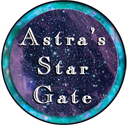

You are here: Space Explorers > International Space Station
First Element: Zarya, launched November 20, 1998
The Station completes an orbit around the Earth every 90 minutes
The Station orbits at an altitude of 250 miles above Earth
The last shuttle mission to ISS was STS-135; it returned to Earth on July 21, 2011
The first commercial resupply mission was launched on May 22, 2012 on SpaceX's Falcon-9 with a Cargo Dragon resupply.
The first commercially launched human crew was on May 30, 2020 by SpaceX Falcon-9 on Crew Dragon.
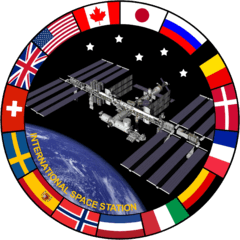
International Space Station's 20th anniversary - the 1st human crew boarded the station on November 2, 2000
On this page: ISS Pages | Latest Mission | Life on ISS | Resupply Vehicles | International Partners | Commercial Crew SpaceX Crew Dragon | Boeing Starliner | ISS Deorbit | Additional Resources
More ISS topics @ Astra's:
ISS-2 Intro | US National Lab | Assembly Continues | New Solar Arrays | Commercialization | Nauka Module | ISS Education
NASA's next crewed launch to ISS is scheduled for March 2026, will take NASA astronauts Jack Hathaway and Jessica Meir, Sophie Adenot (ESA), and Roscosmos Oleg Artemyev on the Crew-12 mission.
The Crew-11 mission launchedon August 1, 2025 carrying NASA astronauts Zena Cardman and Michael Fincke, JAXA astronaut Kimiya Yui, and Roscosmos cosmonaut Oleg Platonov to the ISS.
NASA astronaut Anne McClain, Nichole Ayers, Roscosmos cosmonaut, Kirill Peskov, and JAXA astronaut, Takuya Onishiare, were launched on a SpaceX Crew Dragon on March 14, 2025, for the Crew-10 mission.
- - Find out more @ Astra's about SpaceX
☆ ☆ ☆
NASA astronauts Barry Wilmore and Sunita Williams stranded on the ISS by the Boeing Starliner spacecraft returned to Earth on March 14, 2025. Their eight-day stay on the station stretched to more than nine months. Williams and Wilmore returned to Earth with NASA astronaut Nick Hague and Russian cosmonaut Aleksandr Gorbunov, after the Crew-10 mission reached the space station.
- - Find out about Crew Dragon on this page.
On April 5, 2025, Russian cosmonauts Sergey Ryzhikov, commander and Alexey Zubritsky, flight engineer, and NASA astronaut, Jonny Kim, as flight engineer launched from the Baikonur Cosmodrome. They rode to ISS on Russia's Soyuz MS-27.
Three astronauts launched from the Baikonur Cosmodrome on September 11, 2024. Russian cosmonauts Aleksey Ovchinin, commander and Ivan Vagner , flight engineer, and NASA astronaut, Don Pettit as flight engineer rode to ISS on the Soyuz MS-26 mission.
Three astronauts launched from the Baikonur Cosmodrome on March 21, 2023. Russian cosmonauts Oleg Novitsky, commander and Marina Vasilevskaya, flight engineer from Belarus Space Agency, and NASA astronaut, Tracy Caldwell-Dyson as flight engineer. They rode to ISS on Russia's Soyuz MS-25.
On September 27, 2023, Russian cosmonauts, Oleg Kononenko and Nikolai Chub, and NASA astronaut, Loral O'Hara reached the ISS on Russia's Soyuz MS-24 mission.
☆ ☆ ☆
Boeing's Boeing Crew Flight Test (Boe-CFT) launched on June 4, 2024 and returned uncrewed to Earth on September 7, 2024.
- - Find out more on this page at Astra's

Roscosmos has been launching cosmonauts and astronauts to the International Space Station since the early days of human presence aboard the station. Find out about these launches at NASA.
Soyuz Launches, Arrivals and Departures
You will also find links to all launches to the ISS from every source and a Soyuz image gallery.
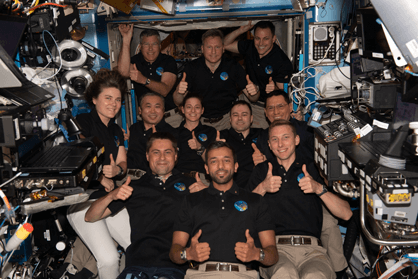
The 11-member crew aboard the International Space Station give thumbs up signs in this portrait. In the bottom row from left are Flight Engineers Andrey Fedyaev of Roscosmos, Sultan Alneyadi from UAE (United Arab Emirates), and Woody Hoburg from NASA. In the middle row from left are Flight Engineers Anna Kikina from Roscosmos, Koichi Wakata from JAXA (Japan Aerospace Exploration Agency), Nicole Mann from NASA, Dmitri Petelin from Roscosmos, and Frank Rubio from NASA. In the back are Flight Engineer Stephen Bowen from NASA, Commander Sergey Prokopyev from Roscosmos, and Flight Engineer Josh Cassada from NASA.
This picture was posted by NASA showing the 11 crew members at the ISS in early March. The record for the largest population on the ISS was set in 2009 with 13 people on board. Crew members Josh Cassada, Nicole Mann, Anna Kikina, Koichi Wakata returned to Earth on March 11. The rest of the crew listed above will go on to Expedition 69 and remain on the station until October. The space station must seem smaller when the crew is so large.
NASA image ISS068e069112.jpg was downloaded from NASA Johnson's Flickr album March 2023. The caption for this image also comes from NASA.

Astra presents the Utilization, Commercialization and Assembly of ISS continued - and information on the ISS National Lab - allowing mere Earthlings to use the facilities of the US laboratory in space.
NASA's Space Station Main Page - or enjoy NASA's - ISS Image Gallery
Flickr photostream - from NASA Johnson the latest images for human space flight
NASA's Space Station Reference Manual
European Space Agency's website International Space Station
Japan Aerospace Exploration Agency's JAXA ISS and KIBO Website
Get to Know the Space Station - Space education STEM for Educators and students
Two astronauts who are also teachers lived and worked aboard the station: Joe Acaba (Sept 2017 - Feb 2018) and Ricky Arnold (Mar 2018 - Oct 2018)!
The latest expedition is #73/74. Crew includes Roscosmos (RKA) cosmonauts Sergey Ryzhikov (Commander), Alexey Zubritsky, and Oleg Platonov; NASA astronauts Jonny Kim, Zena Cardman and Michael Fincke; JAXA astronaut Kimiya Yui.
From NASA - Find out who is on the international space station now!
Human Spaceflight and Exploration
Where is the ISS?- find out from NASA's - See it from your own backyard !
PBS Space Station- A rare view inside the station
History of International Space Station (NASA) Some general history of space stations can be found here.
Amateur Radio on International Space Station ! - ARISS student activity - ARISS home page
Life on the International Space Station - from the Astronauts
NASA's Space Station Blog discusses what is happening on the ISS and stores monthly archives.
International Space Station - Inside ISS - posted March 2016
Sunita Williams gives a complete half-hour tour of the International Space Station. This is a must see video! Learn how astronauts work, eat, sleep, exercise, and yes - use the bathroom! The tour takes you through laboratories, lets you visit the cupola, see the heart of ISS in the Russian modules and even takes you into the Soyuz capsule that brought Sunita and Yuri Malenchenko and Akihiko Hoshide back to Earth on November 19, 2012.
Work, Float, Eat, Dream: Life on the International Space Station - Air and Space Magazine
This October 2020 article includes short stories from ISS astronauts, all of them have spent a good deal time on ISS and hold various duration records: Christina Koch, Samantha Cristoforetti, Paolo Nespoli, Andrei Borisenko, Jeff Williams, and longest tour of duty for all humans in space, Gennady Padalka (878 days).
Living on the ISS - ESA astronaut Frank De Winne - Youtube Video (9:20)
Crew Quarters - Mike Fincke's quarters on ISS during Expedition 18 - Youtube Video (1:29)
Expedition 29 - Mike Fossum - Mike's blog begins with the cupola, the astronauts picture window over the Earth.
Letters to Earth - Don Petit - follow Don's mission, his space poetry, and experiments Expedition 30 - 31
Leroy Chiao's Blog - Astronaut Chiao flew on 4 space missions and served as the Commander of Expedition 10
Station Science - Laboratory in Space
National Laboratories NASA's CASIS science facilities utilization plan
In 2005, NASA Authorization Act designated the U.S. segment of the ISS as a National Laboratory and directed NASA to develop a plan to "increase the utilization of the ISS by other Federal entities and the private sector…"
International Space Station Laboratories Destiny, Columbus, and Kibo
Fluid Integrated Rack - NASA main page
Combustion Integrated Rack - NASA main page
Fluid Integrated Rack - From NASA Glenn Research Center
Combustion Integrated Rack - From NASA Glenn Research Center
National Laboratory - For Earthbound users of ISS laboratory facilities
The international partnership of space agencies working together on the space station includes the space agencies of the United States, Russia, Europe, Japan, and Canada. This very complex project illustrates how possible it is for nations and people to work together, unifying the planet and our ventures into the new frontier.
Roscosmos contributed core space modules: Zarya the first module was later joined by Unity (NASA). The 3rd ISS module was Zvezda. These modules were they launched on Proton rockets. Roscosmos' Rassvet module was launched on the Atlantis Space Shuttle was added to the station in May 2020. Another module, Nauka or Multipurpose Laboratory Module (MLM) module is now expected to be launched in 2021. Roscosmos began launching astronauts and cosmonauts to the space station in October 2000. From August 2011 to May of 2020, the only way to get to the space station was on a Roscosmos spacecraft. This changed when SpaceX and Crew Dragon began taking astronauts in May 2020.
Russia - SPARC brief by Seonhee Kim
JAXA - Japan Aerospace Exploration Agency
Japan's contribution to the ISS includes the Japanese Experiment Module (JEM), that is called "Kibo" that means hope in Japanese Kibo represents Japan's first human-rated space facility. In addition the - Transfer Vehicle (HTV). The vehicle is called Kounotori means "white stork" that is is thought to be carrying good things.
ESA - European Space Agency
ESA was established in 1975 and headquartered in Paris. There are ten founding members: Belgium, Denmark, France, West Germany, Italy, the Netherlands, Spain, Sweden, Switzerland, and the United Kingdom. Their contributions include Columbus Laboratory Module and resupply missions. Columbus is a research laboratory for experiments in material science, fluid physics and life science.
Canadian Space Agency - Canadarm2
Established in 1990, Canada was the third country to launch a satellite. In 1972 launched the first geostationary communications satellite. Canada's contribution is the Mobile Servicing System. This consists of the control system and Canadarm2. Nine Canadians have visited ISS.
Because the ISS has been continually inhabited since November 2, 2000, a constant supply of consumable materials and waste management is necessary. The ISS is resupplied by various space organizations using spacecraft that operates autonomously.
Roscosmos Progress spacecraft

The highly-reliable Progress resupply vehicle is an automated spacecraft that is used to bring supplies and fuel to the International Space Station. The Progress can also raise the station's altitude and orientation of the station with its thrusters. This keeps the station in the appropriate orbit to safely orbit the Earth.
Manufactured by the Russian corporation Energia, the Progress can bring supplies for the astronauts or fuel for use by the ISS. Missions are designated for cargo (supplies) or fuel.
The Progress spacecraft is launched to the space station from the Baikonur Cosmodrome in Kazakhstan on a Soyuz rocket. Progress can stay in orbit for up to six months, and normally undocks shortly before a new one is launched. Progress vehicles have also conducted secondary missions after their cargo resupply flight was complete, including scientific experiments and technical demonstrations in space. they are not re-usable.
- read more at NASA on Progress
ESA Automated Transfer Vehicles (ATV)
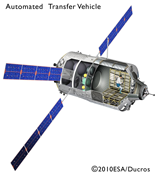
Five ATVs were launched to resupply the ISS by the Ariane 5 heavy-lift launch vehicles. ESA's ATVs had 3x the capacity of the Russian Progress cargo spacecraft. Operating from March of 2008 until July 2014. The ATVs at the ISS were also used to boost the station into a higher orbit.
The 5 ATVs were named after famous European figures: Jules Verne, Johannes Kepler, Edoardo Amaldi, Albert Einstein, and Georges Lemaitre.
JAXA Kounotori - H-II Transfer Vehicle
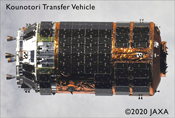
The H-II Transfer Vehicle (HTV) is launched from the Japan's Tanegashima Space Center on an H-IIB launch vehicle. It completed its last resupply mission in May of 2020 and has visited the space station 9 times since 2009. The spacecraft does not dock to the station, instead it is grabbed by the Canadarm2 and it guided to the docking node manually.
- read more at JAXA on- Kuonotori
Cargo Dragon - SpaceX
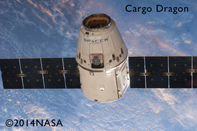
The first Dragon spacecraft launched Dec. 8, 2010 as COTS Demo Flight-1 on a Falcon 9 rocket and was successfully recovered after re-entry through Earth's atmosphere. (In November of the 2010 Federal Aviation Administration issued a its first re-entry license!) SpaceX's Cargo Dragon is the only spacecraft currently capable of returning to Earth with cargo. Like Kounotori, Cargo Dragon is captured by the Canadarm and attached to the space station, so has no docking capability. As of November 2020, the SpaceX Cargo Dragon has visited the ISS 22 times.
Cargo Dragon 2, is an updated version of the original Dragon spacecraft capable of docking directly to the station. The first resupply mission that Cargo Dragon 2 flew was Commercial Resupply Services-21 (CRS-21) that performed an automated docking on December 6, 2020 to Node-2/Harmony's zenith docking port. Dragon2 does not have to be attached to the station by the CanadaArm.
As of the update of this page, SpaceX has sent 31 cargo missions to the ISS for resupply.
Check out this NASA blog that covers SpaceX Cargo Dragon Resupply.
Cygnus spacecraft - Northrop Grumman
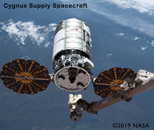
Northrop Grumman has visited the ISS 21 times since its first mission in 2014. Like some other supply vessels, it is captured by the robotic arm and then attached to the ISS. Cygnus is launched on Northrop Grumman's Antares rocket. On August 2, 2023, the NG-19 resupply flight launched from Wallops Island. Mission NG-19 was named Laurel Clark after the astronaut who died on the Columbia space shuttle. It is the last Cygnus spacecraft to be launched on an Antares rocket, because Russian parts can no longer be used. The latest Cygnus resupply flight was launched on a Falcon 9, using a modified fairing.
The Commercial Crew Program is a human spaceflight program operated by NASA. Two American aerospace manufacturers, Boeing and SpaceX, are the main corporations involved. This program allows private enterprises to transport crews to and from the International Space Station (ISS). The two spacecraft that have been developed are SpaceX's Crew Dragon and Boeing's CST-100 Starliner. SpaceX has successfully launched NASA astronauts to the station. Boeing continues its development of the Starliner capsule. The Crew Flight Test (CFT) of Boeing’s CST-100 Starliner is currently scheduled to launch in April 2023.
NASA's Commercial Crew Program
Commercial Crew Press Kit PDF - Download for detailed information
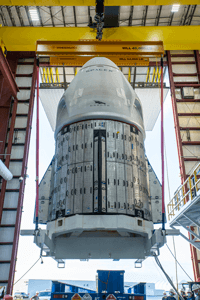
The image of Crew Dragon shows the spacecraft's arrival at Kennedy Space Center’s Launch Complex 39A on November 5, 2020.
The Crew-11 mission launched on August 1, 2025 carrying NASA astronauts Zena Cardman and Michael Fincke, JAXA astronaut Kimiya Yui, and Roscosmos cosmonaut Oleg Platonov to the ISS.
SpaceX launched NASA astronaut Nick Hague and Roscosmos cosmonaut Aleksandr Gorbunovare were launched on a SpaceX Falcon 9 on September 28, 2024, for the Crew-9 mission. Because of issues caused by the Boeing Crew Flight Test, NASA astronauts Zena Cardman and Stephanie Wilson, will be reassigned to a future mission.
SpaceX launched NASA astronauts Anne McClain, Nichole Ayers, Roscosmos cosmonaut, Kirill Peskov, and JAXA astronaut, Takuya Onishiare, were launched on a SpaceX Crew Dragon on March 14, 2025, for the Crew-10 mission.
SpaceX launched the Crew-8 mission on March 3, 2024, from Kennedy Space Center. NASA Astronauts, Matthew Dominick, Michael Barratt, and Jeanette Epps flew with cosmonaut, Alexander Grebenkin.
SpaceX launched the Axiom-3 mission (Ax-3) on January 18, 2024. The crew includes Michael López-Alegría as Commander, Walter Villadei as Pilot, Alper Gezeravcı and Marcus Wandt as Mission Specialists. Although scheduled to undock from the ISS on February 6 bad weather at the Cape moved the return to February 9, 2024.
NASA’s SpaceX Crew-7 mission launched on August 22, 2023 from Kennedy Space Center carrying NASA astronaut, Jasmin Moghbeli, ESA astronaut, Andreas Mogensen of Denmark, Satoshi Furukawa of JAXA , and Roscosmos cosmonaut, Konstantin Borisov to the ISS. Andreas Mogensen will be the first non-American to serve as pilot of Crew Dragon Endurance. The crew launch took off on a SpaceX Falcon 9 rocket from Launch Complex 39A.
SpaceX Crew-6 mission launched to ISS on March 2, 2023 from Launch Complex 39A at NASA’s Kennedy Space Center in Florida. NASA astronaut, Commander Stephen Bowen, Pilot Warren "Woody" Hoburg, Mission Specialist UAE (United Arab Emirates) astronaut Sultan Alneyadi, and Mission Specialist Roscosmos cosmonaut Andrey Fedyaev docked the Crew Dragon spacecraft, Endeavour to the forward port on the Harmony module of ISS.
SpaceX Crew-5 mission was commanded by NASA astronaut Nicole Mann and piloted by Josh Cassada, JAXA astronaut Koichi Wakata, and Russian cosmonaut Anna Kikina who is the first Russian to launch on a Dragon spacecraft. Crew-5 was launched on October 5, 2022 on the Crew Dragon Endurance. The astronauts returned safely to Earth splashing down in the Gulf of Mexico late on March 13, 2023.
SpaceX launched NASA’s Crew-4 mission on a Falcon 9 rocket from Launch Complex 39A at Kennedy Space Center on April 27, 2022. The Crew Dragon carried NASA astronauts Kjell Lindgren, Robert Hines, Jessica Watkins and ESA's Samantha Cristoforetti who arrived at ISS on April 27, 2022. SpaceX's Dragon spacecraft returned the Crew-4 astronauts back to Earth on October 14, 2022.
SpaceX launched 4 civilian commercial astronauts on the Axiom-1 mission from the Launch Complex 39A at Kennedy Space Center on March 30, 2022. The Axiom crew will conducted science, outreach, and commercial activities for eight days on orbit. This mission is the initial in-space startup for the Axiom commercial space station. Current plans for a second mission (Ax-2) call for a launch sometime between Fall 2022 and Spring 2023.
Find out more about the Ax-1 mission at Astras.
SpaceX launched NASA’s Crew-3 mission on a Falcon 9 rocket from Launch Complex 39A at Kennedy Space Center on November 9, 2021. The Crew Dragon carried NASA astronauts Raja Chari, Tom Marshburn, and Kayla Barron, and European Space Agency astronaut Matthias Maurer to the International Space Station.
SpaceX Crew-2 mission launched NASA astronauts Shane Kimbrough and Megan McArthur, Akihiko Hoshide (JAXA), and Thomas Pesquet (ESA) astronauts to the space station on April 23, 2021. Megan McArthur is the first female pilot of the Crew Dragon. Megan is married to NASA astronaut Bob Behnken, who flew to ISS in the same Crew Dragon capsule less than a year ago.
The second launch of Crew Dragon blasted off for the ISS on November 14, 2020 carrying NASA astronauts Victor Glover, Michael Hopkins, Shannon Walker and Japan Aerospace Exploration Agency astronaut Soichi Noguchi to join with the three astronauts already on the ISS in Expedition #64. This brought the total of Astronauts on the space station to 7, the maximum number ever on a full expedition.
The "extra" astronaut was possible because the Crew Dragon spacecraft remained at the station to provide a return trip for 4 astronauts. Previously, two Soyuz spacecraft could be docked at the ISS and they only carry 3 astronauts. Astronauts are not left on the ISS without an escape vehicle for safety reasons. Another SpaceX "first" for this mission was that the vessel docked to the ISS without assistance from the Canadarm2.
On May 2, 2021 at 2:56 a.m. Crew Dragon splashed down by parachute, landing in the Gulf of Mexico near Panama City, FL. This was the first night splashdown from space since Apollo 8 returned in December 1968.
SpaceX Crew-1
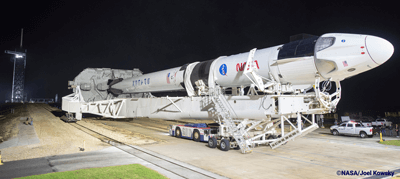
The Crew Dragon spacecraft on the SpaceX Falcon 9 rocket being rolled out to Launch Complex 39A for the Crew-1 mission.
SpaceX Demo-2 successfully launched astronauts to the space station and returned them to Earth!
Falcon 9 launched from Launch Complex 39A at NASA's Kennedy Space Center in Florida on May 30, 2020 at 1:29 am EDT. It was Crew Dragon's second demonstration mission as part of NASA's Commercial Crew Program. NASA astronauts Bob Behnken and Doug Hurleyare the first two NASA astronauts to fly onboard the Crew Dragon spacecraft to the International Space Station. The two astronauts returned safely on Earth on August 2, 2020.
This was the first human spaceflight launched from U.S.A. soil since the Space Shuttle retired in 2011!
Get the full scoop at:
SpaceX - Crew-1 Mission and the Demo-2 mission Crew Demo-2 Mission
Launch America - - from NASA
Live from Space: Inside the SpaceX's Dragon Endeavour Spacecraft - video length 5:13
What is is like to travel to the ISS and back on SpaceX's Crew Dragon? Join Felix Schlang and What About It? on your own special trip to the station on Crew Dragon. Join the crew on this YouTube video!
Unveiling the Secrets: Ride Inside SpaceX's Mind-Blowing Crew Dragon!
- - Find out more @ Astra's about Crew Dragon
☆ ☆ ☆
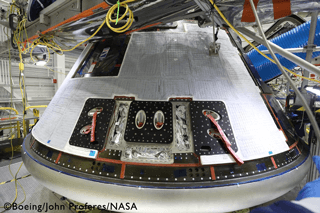
Boeing's Starliner is the second commercial crew launch vehicle that was approved by NASA. It was designed to accommodate 7 passengers, or crew and cargo for missions to low-Earth orbit. The space craft is made up of a crew compartment and a service module that contains the thrusters and propellents of the propulsion system.
Starliner’s second uncrewed flight test to the ISS is known as Orbital Flight Test-2 (OFT-2). This test was to prove the system was ready to fly with human crew aboard. In August 2021, issues in the propulsion system caused the vehicle to be removed from the launchpad and repaired before the OFT-2 test could be undertaken.
Starliner's OFT-2 launched on May 19, 2022, carrying Rosie the Rocketeer test dummy, and successfully docked with ISS on May 22. It rode on an United Launch Alliance Atlas 5 rocket from Cape Kennedy, FL. The Starliner spacecraft named, Calypso returned to Earth on May 25, landing successfully.
The first crewed flight of Starliner is also known as Boeing Crew Flight Test (Boe-CFT). NASA astronauts Barry Wilmore and Sunita Williams were assigned to travel in Starliner. After many delays, the mission finally launched on June 5, 2024. The mission was to last eight days, returning to Earth at Boeing's White Sands Space Harbor in New Mexico, on June 14. However, when docking to the ISS, Starliner experienced helium leaks and thruster issues. This caused NASA and Boeing to extend the mission to investigate the problems with the systems on the spacecraft.
While testing on Starliner was being carried out, the astronauts had to stay on the ISS. Eventually, it was decided that a valve control was overheating and expanding, causing the system to shut down.
NASA decided not to allow the astronauts to return on Starliner. Instead they will return to Earth on the Crew Dragon, Freedom, scheduled to launch the Crew 9 mission. In order to return astronauts, it is necessary to have a returning vehicle. Because Crew 9 had not launched, NASA was able to give them slots to return by only sending the two astronauts intended for Expedition 71. The Crew Dragon also has to carry space suits for astronauts Wilmore and Williams because the Starliner spacesuits are not compatible with the Dragon capsule.
On September 7, 2024 05:01 UTC, Starliner returned landing flawlessly. Unfortunately, the failing thrusters and the propulsion system must be jettisoned before the spacecraft re-enters Earth's atmosphere, preventing engineers from examining the actual failed components.
Starliner’s first crewed mission was part of a series of demonstration missions required by NASA in order to certify that Starliner is qualified to carry astronauts to and from the International Space Station. NASA astronauts Mike Fincke, Scott Tingle, and Canadian Space Agency astronaut, Josh Kutryk. have been selected for the inaugural crewed flight of the Starliner designated, Starliner-1. But for now, it is unknown if this flight will occur and who will be on it.
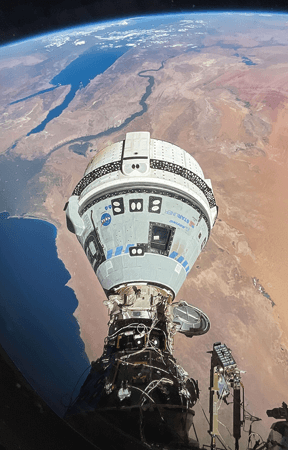
- - Read more about Boeing and Starliner on Astra's Commercial Space page
☆ ☆ ☆
Even the greatest space missions come to an end. The International Space Station has been orbiting Earth since 1998 and is expected to end its mission around 2030. The ISS has a mass of 925,335 pounds or 19,725 kilograms not counting visiting vehicles. The ISS has living space for six people plus visitors, two bathrooms, a gym, multiple laboratories, and a 360-degree Earth-facing window.
NASA, the Canadian Space Agency, European Space Agency, Japan Aerospace Exploration Agency, and Roscosmos are the main space agency partners that are working together to develop the ISS deorbit plan. Over two decades of operations, astronauts have conducted thousands of experiments in space, and engaged millions of students, and maintained the station that today contains 18 pressurized modules.
On June 26, 2024, NASA announced that SpaceX was awarded a contract valued at up to $843 million to build the deorbit vehicle (DV) that will move the station down toward the Earth so that it will burn up in Earth's atmosphere. The DV will be owned and operated by NASA. The heavy-lift rocket needed to launch the DV has not yet been selected.
To lower the ISS altitude for a controlled re-entry, the DV will carry ~35,000 pounds of propellant and be powered by 46 Draco rocket engines. The vehicle will have an extended trunk section and carry out the deorbit maneuvers. More information will be posted on Astra's Stargate in the near future.
NASA published a white paper in June 2024 discussing the various possiblities for the deorbiting the International Space Station. This paper discusses the various prospects for the ISS future but the decision to deorbit has already been made. A video covering the white paper was produced by Derek Richardson, the journalist who owns the Space Bucket YouTube channel.
A Closer Look At SpaceX's New ISS Deorbit Vehicle - The Space Bucket youTube channel.
Download the PDF of the NASA's white paper International Space Station Deorbit Analysis Summary
☆ ☆ ☆
Online Videos for ISS
In 2020 there must be hundreds of ISS videos out there. Try NASA's video gallery
Docking of Progress to ISS - YouTube (8:51)
Undocking of Proton from ISS - video length 5:51
Mir Station Collision - YouTube (8:36) - Working in space is dangerous!
Tour of ISS (Part I) - hosted by Astronaut Mike Fincke - video length 9:43 - Part II - video length 9:58
HD crew choice, no narrative - video length 13:28
Astronaut Recruitment
Fly NASA! The Sky is Not the Limit! - Dan Burbank - video length 1:09
NASA Student Recruitment Video - video length 1:35
Interactive Learning for ISS
ISS Expedition XXX - 30th Crew aboard the International Space Station
Launched Wednesday, December 21, 2011
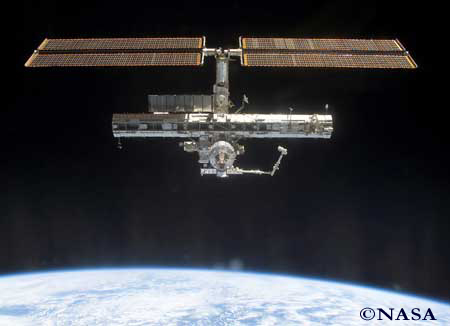
The image of the International Space Station above was taken
from the Space Shuttle on mission STS-113, the appearance of the station from December 2002
until September 2006. The image at the top of this page was taken by the crew of
Discovery on STS-133 when it departed the station in March 2011. These and other images of the space station are available at NASA, and can be reached by clicking on this link:
International Space Station Photo Gallery this will take you to the page that contains the NASA image gallery showing the progress of ISS as it was and is being built.
Last update: 08/03/2025
[ Astronomy ] [ Space ] [ StarWimin ] [ NE Asteroids ] [ Ancient Astronomy ] [ Observers ] [ What's Up ]